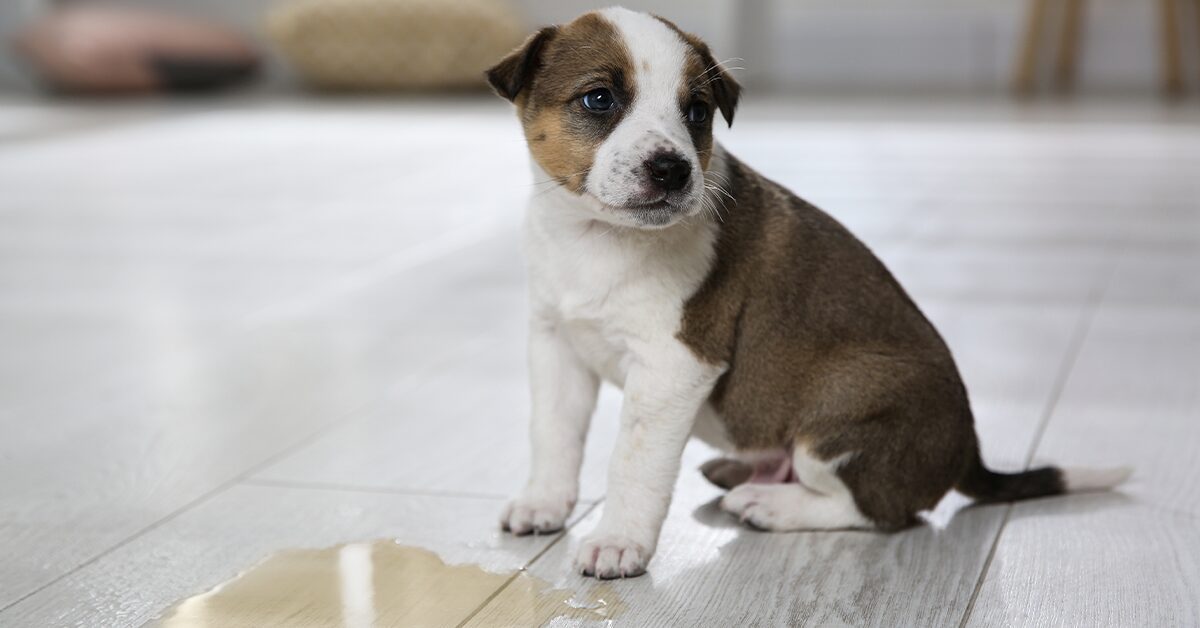You’ve added a new puppy to your family – congratulations! New puppies bring a lot of love, playtime, and (let’s face it) pee and poop. Part of being a great dog owner is teaching your pet good habits, and that includes potty training.
This guide walks you through each step of successful potty training for young puppies on their journey to becoming adult dogs. You can do this!
Getting started
New pet parents have plenty to stock up on. In addition to puppy food, a good collar, pet insurance, and dog training books, you’ll want to be prepared for puppy potty training.
Your potty training arsenal is likely to include:
- A dog crate,
- Potty pads (also known as puppy pads or pee pads), and
- An enzymatic cleaner
Why these three items? A crate helps with many facets of dog training, including potty training. Potty pads, while not for everyone, are particularly helpful in the early stages and/or for apartment dwellers. Lastly, enzyme cleaners just work better. We’ll dive into all of this and more.
Puppy Potty Training: Step-by-Step
1. Familiarize your puppy with their potty area right away
Your new pet’s potty spot should be consistent. The last thing you want is for your new puppy to get confused about where to go.
Supervise your puppy during this process. Keep them contained with baby gates – or in their crate – and take them out when you’re ready to interact or when it’s time for potty. Potty training is most effective when you’re available to your puppy.
2. Establish a schedule
Young puppies benefit from a schedule. A reliable routine helps reinforce good habits for both pet parents and pups. Align your potty breaks to your puppy’s feeding schedule. That way, you’ll both know when it’s time to head outside (or to the potty pad).
Here’s a sample puppy potty training schedule. While you can tweak this, it’s likely to be your routine when your puppy is very young. Be persistent at first, and it will pay off in dividends later. Before you know it, your housetraining days will be far behind you.
Expect to take your puppy out to potty:
- Upon waking in the morning
- At night before going to bed
- After a long play session
- First thing after time in their crate
- First thing after a nap
- After each meal
Nighttime is likely to be a little different. At first, try going frequently, such as once an hour. Once or twice per night is likely to be enough for most puppies, however. You’ll find your rhythm together.
Did we mention that it’s a good idea to take a few days off work when your puppy first comes home?
3. Take frequent potty breaks
Frequent trips are better than too few. Even with a schedule, you’ll want to pay close attention to your puppy’s cues in the early days. If your puppy is showing any signs of needing to go potty, scoop them up and take them to their designated potty area right away.
Here’s what the potty breaks will look like. Take your puppy out on-leash. Stand still and quietly and give them five minutes. You want them to focus on potty. After they go, give them some playtime in addition to a tasty treat.
Repeat these steps throughout the day.
Pet Pro Tip: New kitten owners often underestimate the long-term costs of veterinary care for a pet’s unexpected accidents & illnesses. Make sure you get your kitten insured as soon as possible!
4. Use positive reinforcement for good behavior
Staying upbeat and positive during this process will help both of you. The best way to do this? Be sure to praise your puppy as soon as they go potty – really, right away – and give them a treat. As mentioned, your puppy will associate potty time with good things, and they’ll be motivated to give you the behavior you want.
Dog trainer Patricia McConnell points out on her blog that many pet parents go wrong here by waiting to give the treat. Give the treat immediately after the potty. If you wait until you’re back in the house, your dog won’t understand that the treat is a reward for pottying outside.
5. Don’t punish your new puppy for accidents
Just like rewards will help your puppy learn quickly, punishment will cause them to be fearful and hide from you. If they’re scolded harshly after an accident, they won’t understand the reason. Rather, they’ll learn to be afraid of you, which is the last thing you want. It’s fine to be firm, but always be kind.
In dog training, this rule usually applies: reinforcing the behavior you want is more effective than punishing the behavior you don’t want.
6. Clean up quickly
Accidents happen. The best response is to take them in stride. Move your puppy out of the area, and then clean up thoroughly. Don’t wait to clean. Dogs learn to associate certain areas with potty if they smell like urine or feces. And because dogs have an incredible sense of smell, they’re going to pick up scents that we don’t.
That’s why enzymatic cleaners are so helpful. These products are designed specifically to eliminate odors from pet messes. You’ll find many options at your local pet store or online. Some favorites include Nature’s Miracle and the Biokleen Bac-Out family of cleaners.
How often should I take my puppy to go potty?
Your new dog needs to go potty at least once every three to four hours. That’s because of their bladder capacity – an older puppy or adult dog can hold it in for longer. From six weeks of age until one year, your puppy is still very young, and young puppies just don’t have the bladder control of their adult counterparts. In fact, according to PetMD, puppies typically can hold their potty for their age (in months) plus one.
Got that? In other words: a three-month old puppy can hold their bladder for up to four hours.
What about potty pads?
Potty pads can help with the early stages, especially if you live in an apartment and it takes a few minutes to get all the way outside to an appropriate potty area.
Using potty pads can be confusing for a dog, but they can also be a good interim solution for pet parents who work long hours or live in cold climates.
When using pee pads for your house training process, treat them as you would any appropriate potty spot. Take your puppy to the pad when it’s time for them to go, wait, and then reward them immediately for a job well done.
Does crate training help?
If you’re crate training, you’ve likely placed your dog’s crate in a central location, like the living room. Their kennel is their special place, so they’ll come to associate it with safety and coziness. This is handy for your puppy and for you as you’re supervising them in their first months home.
And yes, crate training helps a great deal with housebreaking. That’s because dogs are den animals, so they won’t want to sully their den (crate). They’re likely to wait, or hold it, until you take them from their crate for potty time.
FYI: Crate training isn’t a good reason to leave your new furball in the crate for the day. In fact, you don’t want to leave young puppies alone in a crate for more than a couple of hours at a time.
That’s a wrap
While it can seem daunting, housetraining your new pet isn’t complicated. It just takes time, patience, and practice. (Well, and a few middle-of-the-night wake-ups for potty time.) But who’s counting when puppy cuddles are involved?




